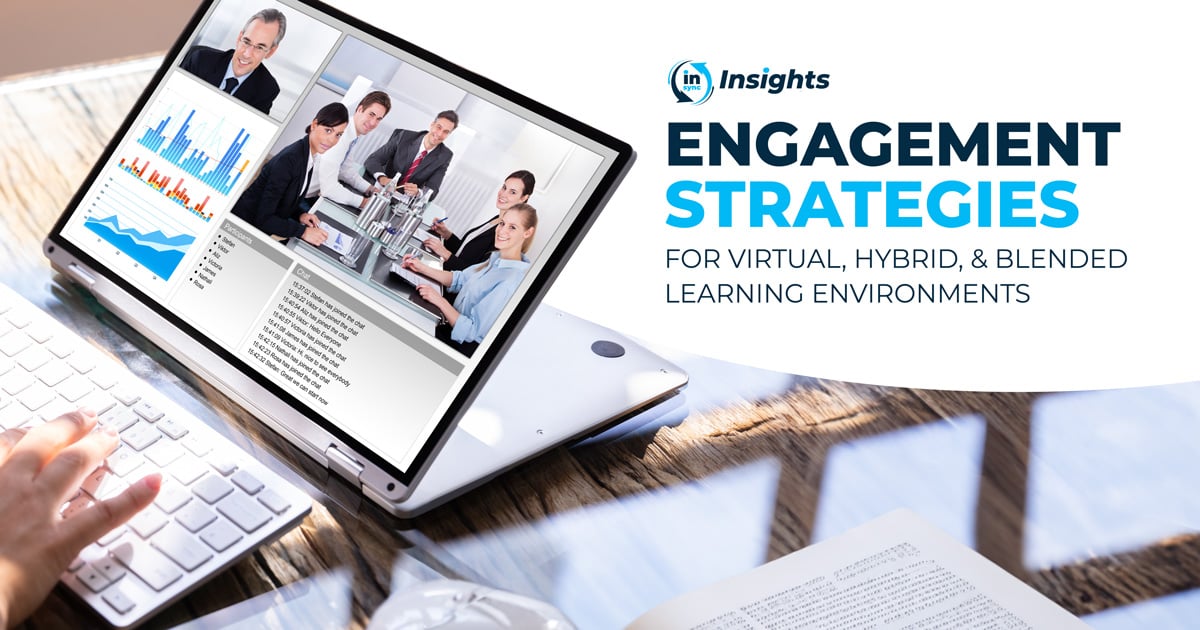6 min read
Best Approaches to Hybrid Learning So No Learner is Left Behind
 Karen Vieth
:
Jan 31, 2022 11:32:08 AM
Karen Vieth
:
Jan 31, 2022 11:32:08 AM
.jpg)
We all know that the learning environment has vastly changed as a result of the pandemic. Hybrid learning, combining virtual with face-to-face instruction, is becoming common. It’s easy to think that hybrid is the best of both worlds – and combining them should be easy.
But what you may not realize when transitioning to hybrid is that it isn't just bolting on virtual with face-to-face instruction -- it's a completely new ball game that only those in the know will be able to survive (and thrive) in.
In this post, we’ll discuss what hybrid is, how it affects learners, and provide 7 key techniques to use when implementing your hybrid learning model to ensure no learner is left behind.
No Learner Left Behind
You’ve seen it:
- three people are logged on independently,
- another five are sitting in a room together watching your session projected onto a big screen,
- and two people are sitting in the same room as you because they wanted a face-to-face experience.
Also, some are on iPhones, and 4 different countries are represented.
Hybrid virtual learning, made so popular during the pandemic, is perhaps the most challenging learning environment. Not only do we need to intellectually engage individual learners, but we also need to anticipate and accommodate so many different environmental scenarios.
It’s so easy to lose track of your learners – especially when you are in a situation where some are right there in the same room with you.
Learner engagement is profoundly dynamic – it’s easy to “lose” a learner if there’s a misstep, intentional or not. If you don’t engage individuals right from the start, you risk losing them for the entire program. It takes focus and a strong understanding of the environment to be successful, and ensure no learner is left behind in the ether.
As organizations continue to define the composition of their workforce, it’s the role of learning and development (L&D) to establish practices to ensure remote learning goals are achieved. Purposeful and thoughtful planning will be the key to the creation and delivery of successful hybrid programs.
What is a Hybrid Learning Environment?... It’s Complicated.
Hybrid learning isn’t about simply combining face-to-face (F2F) and virtual instructor-led training (VILT) – it’s a different learning experience altogether. If we don’t reframe our approach, our training won’t be successful.
And hybrid has the potential to be complicated. It can include:
- A Facilitator with a F2F audience in the same room
- Individuals logged in to a virtual classroom
- on a variety of devices (smartphones, tablets, desktop computers)
- in a variety of locations (private office, at home office, open cubicle, airport lounge, kitchen table, coffee shop)
- Groups of remote individuals sharing the experience by projecting the VILT onto a screen and attending together
- Representation from multiple countries and cultures
It takes experience, and patience, to manage all of these combinations.
Learners using Smartphones? Remember, Their Experience will be Different.
When we design for the virtual classroom, we develop exercises that maximize engagement. Interaction and collaboration are key. The problem is, the mobile versions of most virtual classrooms aren’t fully functional, and learners can’t easily participate.
Viewing slides and listening to conversations is easy, but exercises that require participants to contribute to whiteboards or collaborate in breakout rooms are much more difficult – depending on the software and the device, perhaps even impossible.
This results in different learners having very different experiences, and they don’t reach the same level of mastery. Practice time for mobile learners is often eliminated.
For some programs, we can resolve this problem by only allowing learners with laptops or desktop computers to participate. But sometimes, this isn’t always a reasonable option.
Designers of virtual training need to know at the onset if participants will be participating via mobile devices, and design exercises that enable all of the learners to practice and master content. And facilitators need to apply special techniques to engage learners no matter where, or how, they are participating. But, overall, anytime hybrid learning is employed, it should not be underwhelming.
Multicultural Audience? It’s about Respect.
Technology, like virtual classrooms, helps to propel our global economy – and that’s great. But it adds yet another complication to this hybrid learning environment. “Global” training brings with it different cultures, a variety of native languages, and tons of nuance when it comes to integrating multiple cultures into the same sessions.
While we can’t be an expert of every culture, we can create a culture of mutual respect. If we interact in a way that demonstrates respect for everyone when we make a mistake, learners will be very forgiving. And you can make this an opportunity to learn from them.
To create a culture of respect, you should:
- Recognize the influence culture plays in the classroom. Culture is a 'shared pattern of preferred values, beliefs, attitudes, assumptions, and behaviors that define the way of life for an individual.'
Defining a way of life is a big deal - and while we may not understand, or even support, a particular philosophy, we need to be inclusive in our instruction in order to engage our audience. The multicultural classroom blends participants from various cultures to form a diverse learning environment.
- Identify course and materials design considerations for working with global audiences. First, identify who may potentially be in your audience and learn about the different cultures/nationalities/countries. Case studies and anecdotes should be reviewed so they are relevant to everyone.
Pro Tip: use reviewers from different cultures to provide this feedback. Some materials may need to be translated. Consider exercises that encourage your cross-cultural audience to collaborate in a way that creates trust and not conflict. - Adjust your existing instructional design and facilitation skills to accommodate a global audience. Consider incorporating more reflective exercises and less lecture, so language is less of a barrier. Use a producer to capture key thoughts that are spoken aloud and type them into chat, to ensure understanding.
Moderate your pace, and encourage participants to bring their own experiences to the classroom. And work with local contacts to help you understand local concerns. - Identify challenges regarding technical issues, class dynamics, communication challenges and cultural differences when working with global audiences. Different cultures have different expectations about participation requirements and their relationship with facilitators. When you combine that with the fact that they are bringing their own expectations and paradigms to class, understanding is key.
And remember, not everyone has the same comfort level with the virtual classroom.
Don't be afraid to engage your audience in this conversation. Let people know at the beginning that you are open to feedback regarding content, language, and stories.
And thank them for that feedback - it makes us all better.
7 Ways to Ensure that No Learners Are Left Behind in your Hybrid Learning Model
Hybrid can be successful for everyone – it just takes planning. Here are 7 ways you can help ensure success.
- Have every individual log onto a personal device, no matter how they are participating. This is critical to the success of a hybrid program. Even learners in the F2F environment should have laptops logged into the virtual classroom. Then everyone can participate in shared activities and contribute to chat conversations. It creates a consistent experience.
Pro Tip: In the in-person classroom, the virtual classroom should be projected with the slides running through the platform. Encourage all questions to come through chat before they are spoken aloud – this draws in the remote participants. - Re-imagine the role of the producer as the learner advocate for all participants, no matter how they are participating. Ideally, the producer is co-located with the facilitator and actively manages the virtual experience – ensuring that the voices of remote learners are ‘heard’ by everyone. The producer can especially help a multicultural cohort by repeating and rephrasing activity instructions, using chat to summarize the in-person experience, and being an overall instructional partner. The producer is critical to the success of hybrid.
Pro Tip: The facilitator and producer need to work together as an instructional team, and when the producer ‘interrupts’ the flow of the program, the facilitator needs to trust it is for the good of all the learners. Rehearsal and relationship building is key. - Incorporate learning technologies (video, breakout rooms, whiteboards, 3rd party integrations) that are effective for all environments. While virtual classroom platforms like Zoom and MS Teams have more limited functionality on mobile devices, incorporating products like Mentimeter and Beekast into your VILT designs can engage learners on Smartphones in the same way that they engage learners on less mobile machines.
Pro Tip: Read our recommendations for the best third-party technology integrations to maximize virtual classroom interaction. - During content development, include activity design options that are effective for a hybrid learning audience. There should be options for working individually, working with online groups, and working with a group of people in the same room.
Pro Tip: Don’t plan on co-located learners to interact well with remote learners in breakout activities. It’s hard to manage and has less of an impact. Breakout activities should be designed in a way that makes interaction easy – not more complicated by learners having to figure out how to maximize the engagement for other people. - Facilitate in a way that maximizes emotional engagement and psychological safety of all learners. Emotional engagement is really about safety. All competent facilitators know to keep an eye on their learners, but are they really “seeing” the individuals? Facilitators can gauge whether or not people are actually listening using basic techniques, but how do we know they are actually learning? It’s even more complicated in a hybrid learning environment.
Pro Tip: One way to ensure learners are emotionally engaged is to practice active and reflective listening. This is not as obvious as it might sound – the overabundance of webinars over the last 20 years have taught facilitators that the virtual classroom is about us talking, and not listening to learners. The facilitator, with the support of the producer, needs to ensure the learners are contributing to the class. This creates a sense of belonging and starts to foster community. - Adapt activities ‘in the moment’ to accommodate the actual audience composition. Virtual facilitators are nimble facilitators! Be ready to pivot to maximize the experience for everyone. Use the producer to help you!
Pro Tip: Run some kind of icebreaker in the beginning of a session to get an understanding of the group composition. - Make hybrid part of your blended learning model. As your learner groups become more remote and multicultural, blended learning becomes a more reasonable solution. Blend self-directed and ‘remote group’ learning activities into the program to connect learners in between live sessions. Learners can work on self-directed activities in a language that works for them at a time that works for them, and also collaborate with ‘local’ colleagues.
Pro Tip: Intellectual engagement will certainly be stimulated when the “together” time is used to deepen learning and practice, while self-directed content is used to reinforce foundational materials.
This approach will help your learning organization create effective and engaging hybrid virtual learning experiences and ensure all aspects of the learner experience are accommodated - and no learners are left behind.

Don’t Turn Your Virtual Learners into Zombies
How to tell when learners become zombies and what to do to prevent it We’ve all been in long, dull video calls where we just stare at the camera,...

